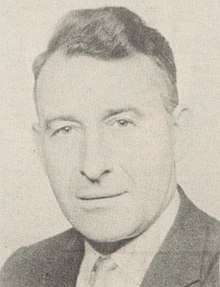Eoin McNamee (Irish republican)
Eoin McNamee (??? - 9 August 1986) was an Irish Republican and former Chief of Staff of the Irish Republican Army.
Eoin McNamee | |
|---|---|
 | |
| Chief of Staff of the IRA | |
| In office c. March 1942 – c. May 1942 | |
| Preceded by | Seán McCool |
| Succeeded by | Hugh McAteer |
| Personal details | |
| Died | 9 August 1986 |
| Military service | |
| Branch/service | Irish Republican Army (1922–1969) |
| Battles/wars | S-Plan |
Background
McNamee is described as having grown up "in the Sperrin Mountains" of County Tyrone and County Londonderry in Ireland, and received little in the way of formal education.“A scholarly, astute, and sane man, with clear perception he saw that a successful revolutionary effort had to be fought on all levels, including political and agitation, but he remained totally committed to the view that armed struggle was the cutting edge or the spear of efforts, the key to victory.” [1]
Irish Republican Army
He joined the Irish Republican Army in 1932 Greencastle, County Tyrone before emigrating to London. He was involved in the Republican Congress, an attempt by the far-left in Ireland to form a political party that would be on good terms with the IRA. However, the Republican Congress split between having moderate Republican goals or an explicitly Communist outlook.[1]
Between 1937 and 1939 he lived in England, still operating for the IRA, working as an "intelligence officer". In March and April 1938 he attended IRA conventions in Ireland and was the spokesman for Seán Russell's faction in the voting for a new Chief of Staff. During this time period he, along with other IRA members who were operating in England, were given a brief introduction into how to create explosives by Seamus O'Donovan and Paddy McGrath as an obvious forerunner to the S-Plan. The S-Plan was a bombing campaign carried out by the IRA against targets in Great Britain during wartime.[1]
McNamee was recalled to Ireland in April 1939 and by 11 June 1939 he was charged with being a member of the I.R.A. and sentenced to six months in Crumlin Road Jail, Belfast.[2] He was released in May 1940 and he returned to Tyrone where he became a leadership figure. IN 1941, McNamee was the Commanding Officer of the IRA's Northern Command.[3]. In March 1942 IRA Chief of Staff Seán McCool was arrested and imprisoned, and that point the job came to McNamee.[1]
He didn't hold the position long however, as he was later arrested again, this time in Dublin on 23 May 1942. He was given a three-year sentence to be served in the Curragh, where he was placed with hundreds of other men from across Ireland who had been arrested for IRA activity by a Fianna Fáil government determined not to allow the IRA to threaten Ireland's neutrality during World War II. During his him in the Curragh he learned Irish and Spanish, while he raised the eyebrows of some detainees when he described Jesus Christ as "as a revolutionary and a socialist".[1] It was also during this period that he is believed to have become a Trotskyist upon conversations with fellow left-wing IRA members in the camp.[4][5]
Later life
Following the years spent in the Curragh, McNamee emigrated to the United States. He moved first to Philadelphia before settling in the Chicago area, where he is supposed to have acted as the go-between for the IRA leadership and its weapons suppliers in the U.S. When the IRA split between Official IRA and the Provisional IRA he choose to side with the Provisionals. He was said to be a close friend of fellow IRA gun-runner and left-winger George Harrison. McNamee was another Irish man who took no time away from Army duties to marry. Even after he had established himself in the United States, first in Philadelphia and finally in Chicago, he surrounded himself not with children and toys but with fellow Irishmen and women whose devotion to Ireland’s full freedom equalled his own. He had joined the IRA in 1932 and remained a faithful son until his last breath. [6][1]
A Sinn Féin cumann is named in his honor: Eoin McNamee Cumann, Kildress, Co. Tyrone. A monument to his memory stands at a quiet crossroad in the Sperrin Mountains of his native County Tyrone.
Sources
- English, Richard (2008-09-04). Armed Struggle: The History of the IRA. Pan Macmillan. pp. 62–. ISBN 9780330475785. Retrieved 29 December 2014.
- Bell, J. Bowyer (1987-01-01). The Gun in Politics: An Analysis of Irish Political Conflict, 1916-1986. Transaction Publishers. pp. 102–. ISBN 9781412837132. Retrieved 29 December 2014.
- Treacy, Matt (2012). The Communist Party of Ireland 1921 - 2011. Lulu.com. pp. 161–. ISBN 9781291093186. Retrieved 29 December 2014.
- Hull, Mark M. (January 2003). Irish Secrets: German Espionage in Ireland, 1939-45. Irish Academic Press. ISBN 9780716527565. Retrieved 29 December 2014.
References
- Hegarty-Thorne, Kathleen (25 July 2019). "The IRA Chief of Staff who was "unbought, unconquered, and unpurchasable to the last"". IrishCentral.com. Retrieved 27 November 2019.
- Coogan, Tim: The IRA A History. Rinehart Publishers (1993), pg131.
- Bell, J. Bower, The Secret Army. New Brunswick, NJ: Transaction Publishers. 1997. p. 187&227. ISBN 1560009012
- Bell, J. Bowyer (1987). The Gun in Politics: Analysis of Irish Political Conflict, 1916-86. Routledge.
Inside the Curragh, Gould not only offered Russian Language classes to the bored but also the ideological temptations of communism. And he began to have some takers and, given the Curragh, some dissenters as ultimately the Trotskyists, including Eoin McNamee (...) outnumbered the Stalinists. Somehow to them Trotsky seemed more anti-imperialist than Stalin.
- Treacy, Matt (2013). The Communist Party of Ireland 1921 - 2011. p. 161.
Boywer Bell claims that Eoin McNamee became a Trotskyist in the Curragh
- Holland, John. "IRA Puts On A Hard Face". irishecho.com. irish echo newspaper, Feb 16, 2014. Retrieved 19 November 2014.